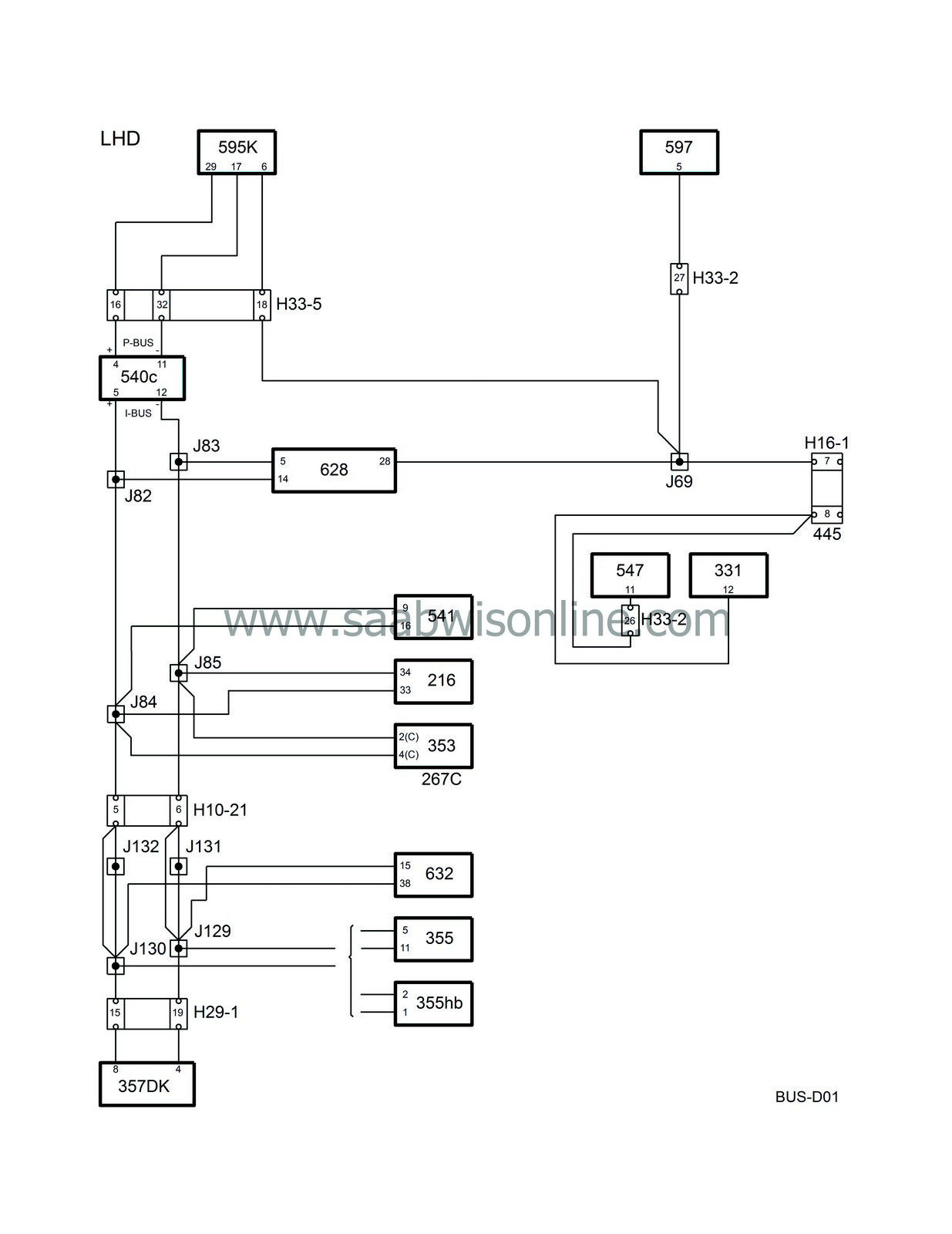Bus communication
| Bus communication |
| • |
ACC control module (216)
|
|
| • |
Radio connector C (267c)
|
|
| • |
Airbag/SRS control module (331)
|
|
| • |
Radio (353)
|
|
| • |
CD changer (355)
|
|
| • |
CD changer, bus connection (355hb)
|
|
| • |
PSM control module (357Dk)
|
|
| • |
MIU (540)
|
|
| • |
SID (541)
|
|
| • |
ABS control module (547)
|
|
| • |
PSG 16 control module (595)
|
|
| • |
Auxiliary heater control module (597)
|
|
| • |
DICE control module (628)
|
|
| • |
TWICE control module (632)
|
|
| P-bus and I-bus |

A bus is understood to be the leads over which information is sent digitally and serially. Digital means that the voltage difference between the leads has only two values, roughly 0 V and 5 V. The information is coded so that different combinations of 0 V and 5 V pulses have different meanings.
Serial means that the information is sent in ”packets” which are transmitted one after the other in rapid succession.
Half of the control modules in the Saab 9-3 are connected to the bus.
The buses consist of a P-bus (Powertrain Bus) and an I-bus (Instrument Bus). Both buses are connected to the MIU (Main Instrument Unit). The buses are electrically isolated from each other.
The diagnostic tool is not connected directly to the bus. It instead communicates via DICE, one of the control modules connected to the I-bus. Through DICE, it has access to all control modules connected to the bus. The PSG 16 control module, however, is directly connected to the K-lead for diagnostic communication.
The data transfer rate of the P-bus is ten times faster than that of the I-bus. This is because the powertrain systems need information with the least possible delay.
All the information transmitted by one of the control modules is available to all the other control modules connected to the bus. MIU is responsible for making the information that is available on one bus also available on the other bus.
The control modules send out information on the bus at regular intervals. The time between two transmissions depends on what information is being transmitted and varies between 10 milliseconds (0.010 seconds) and 1 second. Information is also transmitted by the control module whenever the information changes.
The transfer of information between the control modules takes place on two leads, bus+ (green lead) and bus- (white lead). The two leads are twisted to reduce sensitivity to electrical interference.
| Diagnosis |
In a bus system, all units must be able to communicate with each other. For example, the engine cannot be started if PSG 16 cannot receive the immobiliser information sent by TWICE.
Bus faults
All communication between the diagnostic tool and systems connected to the bus takes place through DICE. Irrespective of which system is contacted, the diagnostic tool first checks by means of DICE that all on-board systems connected to the bus, except for the diesel pump, are turned on and are communicating. If any control module connected to the bus, except for the diesel pump, is missing, the diagnostic tool will show this. This means that all control modules connected to the bus, except for the diesel pump, are communicating properly unless the diagnostic tool warns otherwise.PSG 16 and the diesel pump are monitored by P-bus communication. If a fault arises, a DTC will be generated, see DTC table .
| The PSG 16 control module sends out the following information: |
| PSG 16 sends out | Values | Used by | Value dependent on the following sensor input, signal or function |
|
CHECK ENGINE Lamp
|
ON/OFF
|
MIU
|
Internal diagnostics
|
|
CRUISE Lamp
|
ON/OFF
|
MIU
|
Cruise control function
|
|
Fuel Consumed
|
0-65535 ml
|
MIU
|
Fuel injection function
|
|
Engine running.
|
ON/OFF
|
ACC, DICE, SID
|
Crankshaft position sensor
|
|
Engine RPM
|
0-6000 rpm
|
MIU, ACC, Diesel pump
|
Crankshaft position sensor
|
|
Coolant temperature
|
-50 -200 °C
|
MIU, DICE, ACC
|
Coolant temperature sensor
|
|
Glow indicator lamp
|
ON/OFF
|
MIU
|
Glow function
|
|
Immobiliser
|
Code
|
TWICE
|
Immobiliser function
|
| The PSG 16 control module uses the following information: |
| PSG 16 receives | Values | Sent by | Value dependent on the following sensor input, signal or function |
|
A/C
|
ON/OFF
|
DICE
|
A/C (bus from ACC), coolant temperature (bus from PSG 16), A/C pressure and evaporator temperature
|
|
A/C pressure
|
0-30 bar
|
DICE
|
A/C pressure sensor
|
|
Immobiliser
|
Code
|
TWICE
|
Immobiliser function
|



